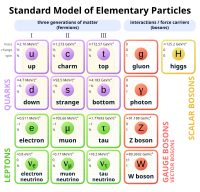
Photo from wikipedia
Topological Josephson junctions designed on the surface of a 3D-topological insulator harbor Majorana bound states among a continuum of conventional Andreev bound states. The distinct feature of these Majorana bound… Click to show full abstract
Topological Josephson junctions designed on the surface of a 3D-topological insulator harbor Majorana bound states among a continuum of conventional Andreev bound states. The distinct feature of these Majorana bound states lies in the 4π-periodicity of their energy-phase relation that yields a fractional ac Josephson effect and a suppression of odd Shapiro steps under radio-frequency irradiation. Yet, recent experiments showed that a few, or only the first, odd Shapiro steps are missing, casting doubts on the interpretation. Here we show that Josephson junctions tailored on the large bandgap 3D-topological insulator Bi2Se3 exhibit a fractional ac Josephson effect acting on the first Shapiro step only. With a modified resistively shunted junction model, we demonstrate that the resilience of higher order odd Shapiro steps can be accounted for by thermal poisoning driven by Joule overheating. Furthermore, we uncover a residual supercurrent at the nodes between Shapiro lobes, which provides a direct and novel signature of the current carried by the Majorana bound states. Our findings showcase the crucial role of thermal effects in topological Josephson junctions and lend support to the Majorana origin of the partial suppression of odd Shapiro steps.The search for experimental evidence of Majorana modes is an area of intense research in condensed matter and quantum physics and uncovering clear evidence is complicated. The authors investigate the impact of Joule heating which can influence the analysis of experimental features related to Majorana bound states in topological Josephson junctions.
Journal Title: Communications Physics
Year Published: 2019
Link to full text (if available)
Share on Social Media: Sign Up to like & get
recommendations!